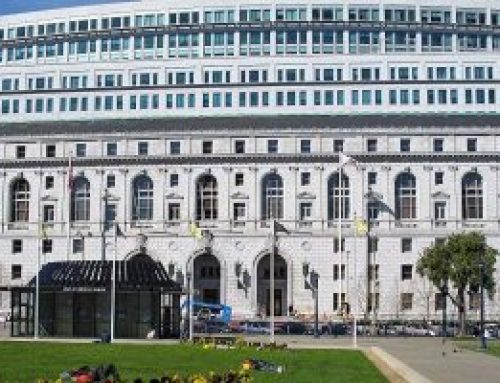If you (or your business) is party to a commercial lease, you are likely concerned during these volatile and uncertain times. COVID-19 has wreaked havoc on businesses across the United States and the world. While we focus on California landlords and tenants in this article, many of the same principles and concepts apply across the board. If you have not already been in close contact with the other party to your commercial lease agreement, you should start those discussions now. Open communication, good faith negotiation, and striking a middle ground is likely the only way for both sides to stay afloat until the economy turns back around.
There are several factors and strategies to consider when engaging in lease workouts. Unfortunately, it isn’t as simple as having the lease contract do some pushups (sorry, it had to be said). Perhaps the best first step to take is a thorough review of the lease terms (hint…have your attorney do this). Then, and only then, will you know what is required, what needs to be addressed, and the best order of priority based on your current position and business needs.
Let’s first review some common lease provisions and legal concepts, including their application to the unprecedented COVID-19 environment. Then we will consider some different options for working out the lease arrangement that both sides may be able to live with.
Force Majeure
The basic principle here is simple and set forth in Cal. Civ. Code § 3526: “No [wo]man is responsible for that which no [wo]man can control.” Most people refer to force majeure as an “act of God” because an event completely outside the control of either party makes contract performance so impracticable that it is excused. Most force majeure provisions typically include conditions such as adverse or extreme weather, casualty (such as fire or earthquake), condemnation, war, strikes, labor disputes, terrorist acts, civil commotion, acts of gods, governmental regulations, etc.
Unlike some other states (such as New York), California law supports the proposition that a non-listed event in a force majeure clause can still fall within the definition of force majeure if the non-listed event is unforeseeable at the time of contract formation and the scale of equity tips in favor of the party seeking to enforce the provision. California applies the equitable principle of force majeure quite broadly, and it is not necessarily limited to the equivalent of an act of God. Rather, the test for whether a force majeure situation exists is whether there has been such an “insuperable interference” which could not have been prevented by the exercise of due diligence.
It is important to note that if, in order to comply with a contract’s terms, a party must incur greater expense or hardship than originally anticipated, that alone does not excuse performing each contract obligation. Instead, the party bearing the burden must prove that there exists extreme and unreasonable difficulty, expense, injury, or loss. Also, any party invoking force majeure must demonstrate that they made sufficient or commercially reasonable efforts to avoid the consequences of the force majeure event, such as seeking other suppliers or other methods of performance. Courts are likely to require that a force majeure claim be accompanied by proof that the failure to perform was proximately caused by an external contingency outside the control of the parties and that, in spite of the skill, diligence, and good faith on the promisor’s part, performance remains impossible or unreasonably expensive.
Often, a key issue is whether the force majeure contract language and circumstances merit only a delay in performance, or a complete termination of all contractual obligations. If the contract contains a “time is of the essence” clause regarding performance of the obligations, and if time truly is of the essence as determined by the court, then a complete termination of all contractual obligations is likely the most equitable result (especially where the force majeure event is causing, or is likely to cause, a very long period of delayed performance).
Application to COVID-19:
No published California court decision has squarely addressed a virus or pandemic in relation to force majeure provisions. Most force majeure clauses explicitly state that the performance of certain non-payment obligations are tolled during the pendency of the force majeure event(s), but that the payment obligations of the tenant must continue. Thus, even if the COVID-19 pandemic is deemed to be encompassed within a force majeure clause, it is very unlikely to excuse a tenant’s obligation to pay rent (unless that was negotiated into the contract).
However, force majeure provisions could still have an impact on key lease obligations. For instance, if a tenant’s performance of property improvements is delayed due to force majeure, then the build-out period (and possibly the rent commencement date) could be extended commensurately, depending on how the lease is drafted. A force majeure provision could also excuse tenants for failing to comply with covenants to open, continuously operate, and/or maximize revenue from the business location. During these trying times of businesses closing, the extension of these obligations is better than nothing, and would at least prevent lease default under those obligations. Also, most force majeure provisions include detailed notice provisions, but the recipient’s office at the address listed for notice could be closed due to COVID-19. As such, it is prudent to send all such notices certified (with return receipt requested) and to also e-mail them to the receiving party.
Keep in mind that issues of contract interpretation (including force majeure clauses) as well as legal concepts such as impossibility and frustration of purpose (addressed below) are all questions of law for the court to decide (assessing things like fundamental fairness, public policy, and the totality of the circumstances), not questions of fact for a jury to consider. As such, instead of waiting to be sued, a party that knows it will not be able to perform its lease obligations should consider promptly bringing an action for declaratory relief. While such party would bear the burden of proof to show justification for failure to perform under the lease, it would have the strategic advantage of “filing first” and initially framing the issues for the court, plus it would provide clarity to know the extent of such party’s liabilities and financial obligations. Of course, this is only if the parties are unable to negotiate a workable solution, which is addressed in more detail later in this article.
Now that we, as a society, have experienced this magnitude of a pandemic, force majeure provisions in future contracts should include specific language addressing viruses, bacteria, illnesses, diseases, epidemics, pandemics, quarantines, shelter-in-place orders, lock-downs, shut-downs, essential versus non-essential businesses and activities, and related negative repercussions such as air travel interruptions, supply chain issues, business interruption or cessation, loss of customers, and overall economic downturn. Lease contracts should contain clear and specific provisions relating to notice being provided of the force majeure event, including e-mail notice as being acceptable if a reply e-mail is promptly sent to confirm receipt.
There should be language that provides for the right of the impacted party to suspend and terminate the contract as appropriate, as well as the time period of suspension before any termination right can be exercised (if that is the desired result). A key negotiation point is whether all obligations should be paused during the period of suspension, or if only some of the obligations should be suspended (such as payment obligations). Going forward, force majeure clauses should be heavily negotiated by competent legal counsel instead of relying on boilerplate language of the past. The party claiming a force majeure event should generally be required to employ its best efforts (or commercially reasonable efforts) to mitigate the effects of the force majeure event (assuming any actions can be taken to do so under the circumstances), so as not to be able to sit back and claim there is nothing they can do. Parties should also consider adding a clause expressly permitting injunctive relief (and/or declaratory judgment) as an appropriate action/remedy to promptly address the situation.
Impossibility
If a lease does not include a force majeure clause (or such clause does not apply to the current pandemic), one legal theory that could achieve a similar result is the doctrine of impossibility. Cal. Civ. Code § 1511 excuses a party’s performance of a contractual obligation when performance is prevented or delayed by operation of law or by an irresistible superhuman cause, which requires that an unforeseeable event was directly responsible for the party’s inability to perform. Significantly, California courts hold that such inability to perform “must consist in the nature of the thing to be done and not in the inability of the obligor to do it.”
Impossibility as an excuse for non-performance includes not only strict and complete impossibility, but also impracticability due to extreme and unreasonable difficulty, expense, injury, or loss involved in performing. Similar to the typical force majeure provisions (unless negotiated very strongly in the tenant’s favor), the doctrine of impossibility typically would only excuse the failure to perform certain non-monetary covenants (such as the duty to stay open and conduct business), not the obligation to pay rent.
Application to COVID-19: As with force majeure, no published California court decision has addressed the impossibility doctrine with regard to a pandemic like COVID-19. Financial difficulty, on its own, is usually insufficient to justify relief under the equitable doctrine of impossibility. Instead, a tenant must demonstrate a clear and direct link between the external event(s) and the tenant’s inability to pay rent. The disruption of supply chains, vendor closures, stay-at-home orders, and other factors related to the current COVID-19 pandemic certainly contribute to an inability to perform due to the “nature of the thing being done,” especially for certain types of businesses such as providing massage services. Other businesses, such as restaurants, are generally able to continue to offer services (albeit at a reduced capacity), so they would have a more difficult time arguing that impossibility to perform waives or extends their obligation to pay rent. Also, as with force majeure, the impossibility doctrine could support providing an extension of construction periods if tenant improvement work is delayed due to COVID-19.
Frustration of Purpose
Frustration of purpose is another common law equitable doctrine which allows a party to terminate a contract if an intervening event occurs which renders the purpose of entering into the contract meaningless. Frustration of purpose exists where performance remains possible but is excused whenever a fortuitous event supervenes to cause a failure of the consideration or a practically total destruction of the expected value of the performance. Unlike force majeure or impossibility, the party does not need to show that performance under the contract is impossible. Rather, the party must show that the primary reason for entering into the contract has been substantially frustrated and is no longer achievable.
The classic example of this comes from a case where a tenant rented an apartment for the sole purpose of watching the coronation of Edward VII. When the coronation was cancelled, the tenant was able to terminate. Even though nothing was wrong with the apartment and the tenant could have occupied it, the entire purpose of the lease was frustrated when the coronation was cancelled.
Application to COVID-19: As with force majeure and impossibility, no published California court decision has addressed the frustration of purpose doctrine in relation to the drastic effects of a pandemic. However, frustration of purpose sets a high bar to overcome and can rarely be used to terminate a commercial lease agreement. Perhaps the only tenants that could avail themselves of this doctrine during these times are those that have leased stadiums or conference centers for events (trade shows, concerts, etc.) that were cancelled due to the COVID-19 pandemic, as well as any tenant that has rented space which is not legally allowed to be occupied by anyone at any time (which would be rare).
Interruption in Services; Rent Abatement
Many leases include interruption in services clauses abating (forgiving) rent if the landlord fails to provide an essential service to the premises or if the property is not able to be occupied by the tenant for more than a certain period of time (usually 3-5 business days, at minimum). These clauses are, on the whole, narrowly drafted and only apply if the interruption was actually caused by the landlord’s negligence (or gross negligence, depending on the language in the lease) and it is within the landlord’s control to correct. However, some interruption in services provisions may be broad enough to provide rent abatement if the premises is rendered inaccessible due to a “government action” or if the landlord otherwise prevents the tenant from accessing the premises.
Application to COVID-19: Although broadly drafted interruption in services and rent abatement clauses are rare, the lease should be carefully reviewed by legal counsel to determine whether any such provisions could apply to governmental orders, building closures, or any landlord-caused interruptions relating to the COVID-19 pandemic.
“Go Dark” Provisions; Continuous Operations; Recapture Rights
Some commercial leases, particularly those for stores at retail shopping centers, contain a “go dark” provision which typically provides that the tenant may “go dark” by not operating its business at the premises so long as the tenant continues to pay rent in full. Sometimes, if a tenant “goes dark” and fails to operate for a certain period of time (as defined in the lease), then the landlord is entitled to terminate the lease and “recapture” (take full possession of) the premises. Typically, these provisions require special notice by the landlord and could require the payment of a recapture fee by the landlord to the tenant. There are also leases where the tenant must provide a separate payment to the landlord in connection with recapture. A “go dark” provision may also contain a negative covenant that prohibits the tenant from going dark for a certain initial period of time after lease commencement. In any event, during any “go dark” period, rent payment obligations remain in place. Any “go dark” provisions should also sync up with the lease’s continuous operations requirements, which are included in most commercial leases. These provisions are widely negotiated.
Application to COVID-19: Nearly every commercial lease requires the tenant to comply with all applicable laws as well as the lease terms. If a lease has a “go dark” clause that prohibits the tenant from going dark for a certain initial period of time (or which states that the tenant may only go dark for a certain number of days before being in default) or if the lease simply requires that the tenant continuously operate (with no exceptions that cover the current pandemic), then the tenant will be faced with a conundrum. Considering the shelter-in-place orders and the abundance of state and local government restrictions on business activities and limitations on gatherings, the tenant may be forced to violate lease covenants requiring continuous business operations at the premises. Any tenant facing such a dichotomy of duties should request from its landlord (in writing) to have the operational covenant (or applicable “go dark” clause) deferred, amended, or waived. In many situations, it simply would not be possible to stay open for business (in order to comply with the lease obligation to operate and not “go dark”) while simultaneously shutting down (in order to comply with all applicable COVID-19 related orders and guidelines from government authorities).
“Good Guy” Guarantee
These types of guarantees typically require the guarantor (usually an individual principal owner of the tenant entity) to personally promise payment to the landlord of all rent owed, with the guarantor released from such obligation only when the tenant actually surrenders the premises on a designated date prior to the lease termination date. It is also usually a condition to the guarantor’s release that all rent be paid through the date of surrender and that the tenant not be in default under any of the lease terms (hence, the “good guy” aspect of this arrangement). This kind of guaranty gives the landlord the ability to regain possession of the property, even if the rent deficiency for the period after the surrender date (and through the technical lease termination date) is uncollectible from the tenant entity. Sufficient notice on the part of the tenant is also required such that the landlord may begin the process of finding a replacement tenant.
Application to COVID-19: Due to the pandemic, many businesses are considered “non-essential” and are unable to operate and satisfy their rent payment obligations. Such rent arrearages create a phantom liability on the balance sheet of the guarantor, which may or may not manifest as an actual liability depending on whether the tenant entity can pull through the current crisis and begin paying its then-current rent and prior rent owed. Accordingly, the language of the good guy guarantee must be carefully evaluated to determine whether it requires the guarantor to be responsible for paying rent obligations accrued during periods that occupancy is precluded by COVID-19 related government actions or economic conditions. In light of the small number of businesses currently seeking new space to rent during these uncertain times, commercial landlords are likely incentivized to reach an accommodation with existing tenants who want to remain and can demonstrate a viable plan for repayment of all outstanding rent obligations once the pandemic ends (or slows) and they begin generating revenues.
Security Deposits
Security deposits are typically paid in cash but may be in the form of a letter of credit issued by a bank and naming the landlord as beneficiary. Some security deposits may be subject to a “burn-off” or reduction over time if the tenant does not default under the lease terms, especially where the landlord provides an allowance for the improvement of the premises for the tenant’s unique use.
California commercial lease security deposits are subject to restrictions on their use by the landlord under California law, which limits the use of such funds to curing defaults in the payment of rent, repairing damages to the property, and cleaning upon lease expiration. Amounts not used must be refunded. However, these statutory provisions are waivable by the tenant and most commercial leases include such a waiver, giving the landlord the right to apply the security deposit to any default by the tenant, including future rent payments owed under the lease. Some leases may impose accounting requirements on the landlord for amounts expended, which can be challenged by the tenant as inappropriate.
For tenants that are insolvent or have filed for bankruptcy protection, the requirements of federal bankruptcy law govern a landlord’s rights in the case of both cash security deposits and letters of credit. On a pre-bankruptcy basis, landlords are sometimes advised to take the cash security deposit and apply it to the delinquent rent to the extent permitted by the lease and not prohibited by applicable state law, although having that application characterized as a preference under bankruptcy law is sometimes a tenant defense. On a post-bankruptcy filing basis, resort to the security deposit is generally prohibited due to the automatic stay. However, if the deposit is in the form of a letter of credit, the automatic stay typically would not apply and the landlord can use the drawn funds to the extent permitted under the lease and applicable law.
Application to COVID-19: While the state of California and many local jurisdictions have imposed moratoriums and restrictions on evictions of commercial tenants during the pendency of the COVID-19 pandemic, such orders generally do not prevent landlords from applying security deposits if a commercial tenant fails to pay rent or perform other lease obligations. Most commercial leases require the tenant to replenish the depleted security deposit, sometimes immediately or within a specified timeframe. Failure to do so usually triggers a separate default by the tenant; however, while eviction prohibitions remain in place there may be no additional actions the landlord could take (aside from placing a demand on the personal guarantor of the lease, if there is one).
Although drawing from security deposit funds may seem like an attractive option for landlords leasing to non-paying tenants, doing so could accelerate a financially struggling tenant’s decision to initiate a preemptive bankruptcy filing because the tenant views the situation as unsalvageable. This could result in potentially bigger issues for the landlord, as it would now be wound up in the complex (and protective) bankruptcy rules. If the landlord’s goal is to keep the tenant (perhaps the tenant has been in perfect compliance for a number of years), then applying security deposit funds toward rent payment obligations could reduce the chances of the tenant being able to weather the COVID-19 storm. Also, as a practical matter, unless the landlord has been preserving the cash security deposit as a separate account or otherwise segregating security deposits from its general accounts, there may be no real cash flow advantage to it in accessing the security deposit other than as a balance sheet entry since those funds may have already been spent in the ordinary course of operations.
Commercial Lease Workout Strategies
Now that we have addressed some of the most common provisions in commercial leases that could apply to the conditions created by the COVID-19 pandemic, it is time to address some actual workout/negotiation strategies. The strategies and options listed below are in no particular order and certainly do not cover all potential avenues to explore. Each situation is different, including the tenant, the landlord, the lease terms, the industry involved, the impact of COVID-19 on the business and premises, the history between the parties, the local jurisdiction’s orders and guidelines, the goals of each party, and so on. As such, competent legal counsel should be involved to help navigate the many factors at play and advocate strongly on the client’s behalf.
- Rent Abatement (Forgiveness): This is usually the tenant’s dream and the landlord’s nightmare. But sometimes a landlord needs to know when it is actually in its best interests to help a tenant survive in the short term so the tenant can thrive in the long term (and pay future rent payments). A landlord may offer to forgive/waive rent payments for a certain number of months (say, 6 months), under the condition that if the tenant ever achieves a certain level of net profits in the future (and during the course of the lease term), then the 6 months of past rent would become due and payable in accordance with a negotiated timetable and payment schedule (ultimately paying back the landlord all rent payments owed under the lease). If the tenant’s business never turns around enough to achieve that level of success, then those 6 months of past rent remain forgiven/waived and the non-payment by the tenant does not trigger a breach of the lease.
- Rent Decrease: Rent payments can be decreased by a set dollar amount or by a percentage of what such rent payments would otherwise normally be, and such decreases may be temporary. As a counterbalancing measure, the lease term could be extended with a greater payment obligation than initially established applying during the extension period.
- Rent Deferment: Defer rent payments to later dates. This is essentially kicking the can down the road for both parties and does nothing to help ease the tenant’s overall financial obligations under the lease. This is also what most eviction moratoriums require, although the specifics of repayment plans are left to negotiations between landlords and tenants. Many tenants view mere deferment (with no other incentives or added benefits) as prolonging the inevitable because if they can’t pay now, how can they be expected to pay the deferred rent in the future (in addition to their then-current rent payment obligations). Repayment schedules for deferred rent may include acceleration triggers for earlier repayment due to future lease defaults or adverse events such as a tenant’s permanent closure of its business, bankruptcy filing, or loan default.
- Rent Restructuring: If rent is a set amount each month (regardless of the tenant’s amount of operating income), the rent obligation can be changed to a formula involving a percentage of net (or gross) revenues. This would likely help the tenant in the short term, but landlords can potentially receive more income in the long run if the percentage is set high enough and the tenant’s business thrives during future years (especially if the lease is still early in its term).
- Modification or Suspension of Non-Financial Covenants: Landlords and tenants should evaluate the non-payment related covenants in the lease (such as continuous operations clauses, “go dark” clauses, etc.) and, where appropriate, suspend or waive those obligations during the pandemic. Failure to do so will cause tenants to find themselves in uncurable default situations, which could set off a cascading series of other defaults and/or landlord remedies which would only compound upon the underlying problems facing the parties. For instance, certain additional tenant rights (such as the right to exercise an option to extend the term of the lease, the right to expand the premises, the right to change the use of the premises, and the right to not have prior rent abatements “clawed back”) are sometimes conditioned on the tenant being in continuous operation of its business and not in default under the terms of the lease. Landlords should act in good faith to suspend or waive certain lease obligations that tenants cannot reasonably be expected to be able to fulfill, such that additional problems do not begin to mount.
- Termination of Lease: The parties should never forget about the option to simply walk away from the arrangement, with each party waiving any and all claims against the other. Sometimes a swift and clean break is the best strategy to allow each party to focus on moving forward with greater clarity. A separation payment may be negotiated, depending on the totality of the circumstances.
In connection with any of the above lease modifications, landlords may (i) seek financially relevant information from the tenant, including bank statements, profit and loss statements, tax returns, the status of the tenant’s business with its lenders and critical suppliers, vendors and customers, and whether the tenant is treated as an “essential” business, (ii) require a clean estoppel statement confirming no landlord defaults, and (iii) attempt to condition any lease concession with a lease extension (potentially applying a higher rental rate during the extension period), an additional personal guarantee, and/or security interest in the tenant’s assets. Also, one or more parties may be required to obtain the consent of a third party (such as a lender) prior to effectuating certain lease amendments or giving concessions.
A landlord may also ask whether its tenant recovered any insurance proceeds due to business interruption or any other reason, and such insurance proceeds (or a portion thereof) could be applied to past, present, and/or future rent payment obligations. The same may be asked of government assistance funds that a tenant might have received. Landlords should request a range of information regarding a tenant’s financial condition and status:
Additional Considerations
Business Interruption Insurance: Many commercial leases require that tenants have business interruption insurance, which generally covers financial loss (including rental payment obligation) caused by direct physical loss or damage to the premises from a covered cause of loss. While most policies exclude coverage for claims caused by virus or bacteria, some insurance companies narrow such exclusions through optional endorsements. Tenants with business interruption insurance should not hesitate to file a claim, as timely claims filing is often required to preserve the right to dispute the decision of the insurance company. Landlords should also review their own rental loss insurance policies to determine whether they have coverage for lost rent arising out of the COVID-19 pandemic.
Temporary Taking: Many commercial leases specify that in the event of a “temporary taking” by the government, rent will not abate but, rather, the tenant will be permitted to file a direct claim against the government for lost rent. Other leases state that in the event of a temporary taking, the tenant is entitled to an abatement of rent during the course of the taking. If a lease includes this language, the tenant may be more likely to demand rent abatement based on a takings argument. While there is no current caselaw that supports characterizing shelter in place orders as a temporary taking by the government, the argument can certainly be made in good faith and doing so could bolster a tenant’s bargaining position, especially if the takings provision in the lease is vague and open-ended.
Casualty: If a tenant’s space or overall building were evacuated due to COVID-19 contamination, such tenant may attempt to characterize such damage as a “casualty,” thereby entitling the tenant to rent abatement until the casualty is gone. Some leases simply state, “if the premises is damaged by fire or other casualty…then rent shall abate until the casualty is repaired” and do not define casualty. Other casualty provisions are more specific and clearly state that they only apply to physical destruction of the premises. Tenants should review the casualty provision in their leases as they evaluate their options to deal with the impact of COVID-19.
Bankruptcy: Unfortunately, the COVID-19 pandemic will bring down many businesses, resulting in landlord-tenant discussions that focus on typical end of lease topics such as turning over the premises to the landlord, damage to and restoration of the premises, and potential settlement of unpaid past, present, and future rent obligations. Some of these tenants will wind down and liquidate their businesses outside of bankruptcy while others will seek bankruptcy protection. For those seeking bankruptcy protection, it will be a difficult market for Chapter 11 debtors to reorganize or for tenants (or Chapter 7 trustees) to find interested and creditworthy buyers to purchase store locations and assume “above market” leases. Under the Bankruptcy Code, a debtor-tenant (or its buyer) is generally required to pay all rent in arrears and provide adequate assurance of future performance by the buyer of the tenant’s lease obligations in order for the debtor-tenant to be permitted to assign the lease to a purchaser. These requirements will likely be more difficult to satisfy because of COVID-19’s continuing negative impact on most companies that may be interested in purchasing a debtor’s entire business or individual lease. Landlords should consider modifying leases and rent concessions to induce buyers or to bring in new tenants. Otherwise, landlords risk potentially lengthy marketing periods before finding suitable replacement tenants at acceptable rental rates while local markets begin to recover.
Conclusion
It is almost always in the best interests of both landlords and tenants to work together to find mutually beneficial solutions to their lease-related problems. Open communication, good faith negotiation, and a willingness to find common ground is the best approach for each side to take in commercial lease workouts during the COVID-19 pandemic. It does not benefit a landlord if its tenant goes out of business because it is not able to pay rent. Similarly, tenants are not ultimately benefited if their landlords are unable to pay their real estate lenders. The most appropriate resolution will depend on numerous factors, including the facts and circumstances of each particular lease, the availability of insurance proceeds, any government relief, the severity of the impact on the parties, and market factors.
Given how dependent all of this is on the language of each lease and with so many novel issues raised by COVID-19 on a seemingly daily basis, landlords and tenants are advised to consult with legal counsel about their specific situations before making any final determinations about the actions they should take, including the negotiation and preparation of any lease amendments. Keep in mind that if negotiations fail, then a court may be deciding your fate for you, so negotiating in good faith is always recommended. Thus, the solution as to the best way forward will almost certainly spring from the business model behind the landlord/tenant relationship with an understanding that while the applicable lease provisions are important, what ultimately matters is arriving at a mutually satisfactory business solution that will allow both sides to weather this unpredictable storm.








